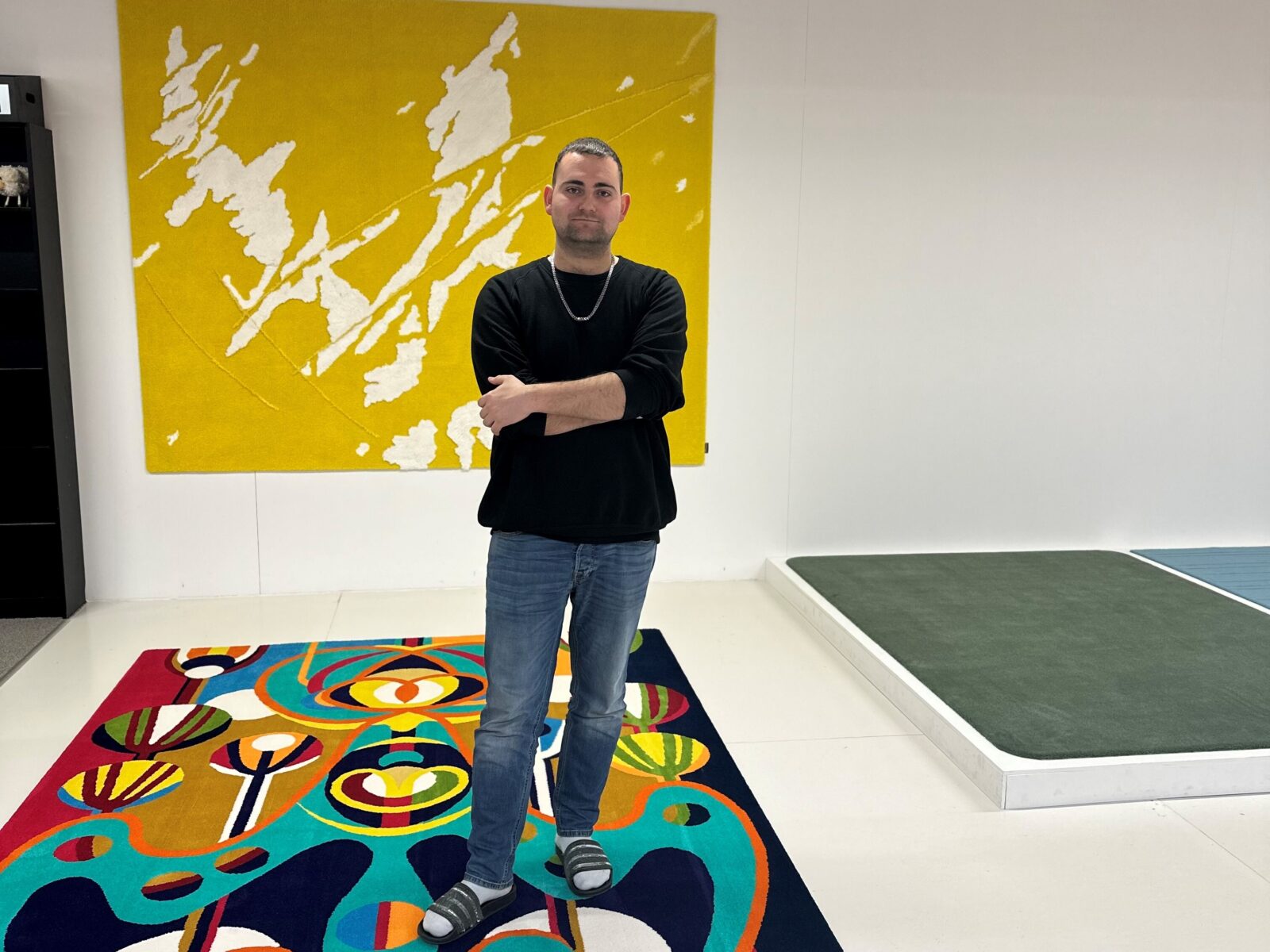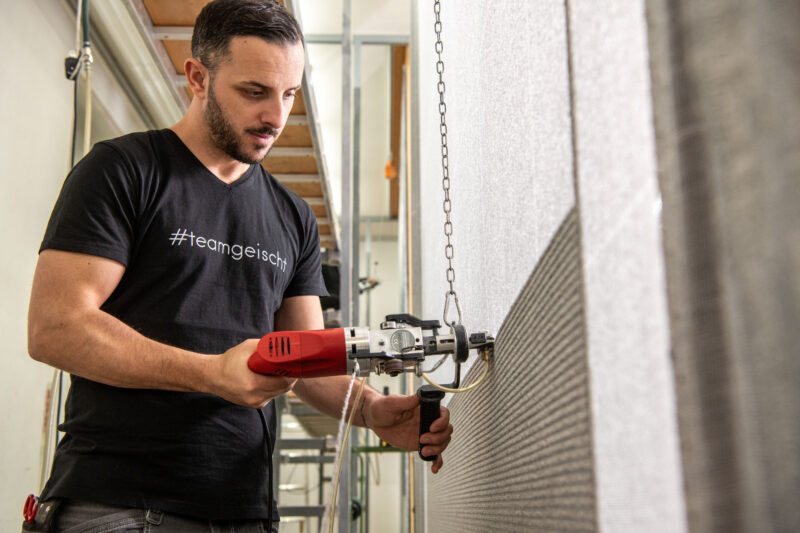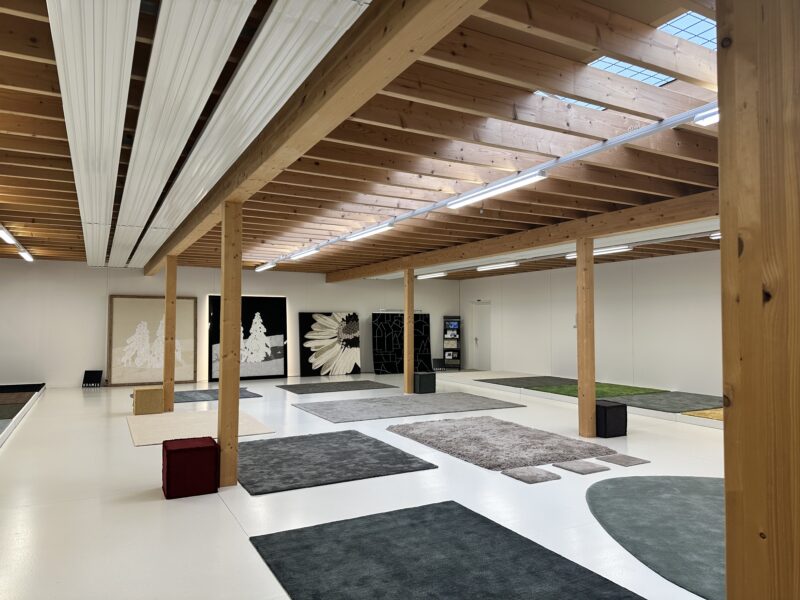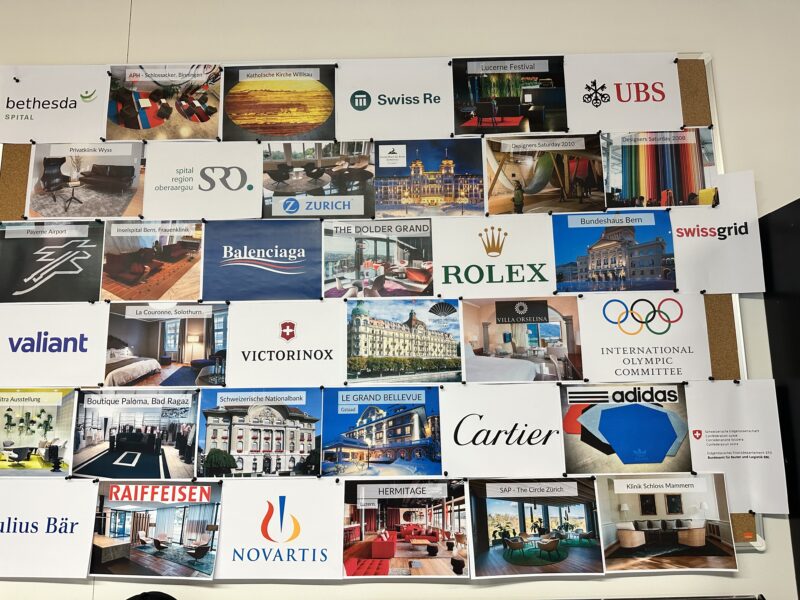Reel SERIES
From carpet to social media pro

Behind the scenes on a visit to Lucerne-based luxury carpet manufacturer Kramis Teppich Design AG, Swiss Textiles talks to Marketing Manager Tim Kramis about social media success, his passion for tufting and an order placed by a star British guitar player.
Swiss Textiles visited KRAMIS Teppich Design AG in January.
6 December 2022 was a red letter day for Tim Kramis of Kramis Teppich Design AG in Altbüron. A reel – or short video – produced by the marketing manager himself on Instagram quickly reached 5.5 million viewers worldwide. It showed employees making colourful rugs by hand. The family firm’s follower numbers shot through the roof. From 9000 to 117,000! The regional media were soon also calling for interviews.
“The response was overwhelming. We were very surprised. Especially because I had seen this as no more than a trial run”, says Tim Kramis, a trained social media specialist and Executive Board member. But he does not think that a degree is indispensable. Courage and creativity are more important in his view. However, he has a word of advice for everyone: “Companies should not use social media as an advertising platform for their products and services,” he explains. A look behind the scenes is far more exciting for users.
People discover tufting as a leisure occupation
Not only has this handmade luxury carpet manufacturer’s follower numbers have grown. Interest in the handicraft of tufting, as it is known, has also risen massively: “Many people from the world of design, art and interior architecture want to learn this technique. Private persons have discovered it as a hobby,” Tim Kramis explains. This occupation lends itself to meditation and is in effect a form of therapy. The fascination arose already during the pandemic when many people were sitting at home and had to find occupations. Meanwhile countless tutorials can be found on the Internet. For small wall-mounted rugs or decorative underlays – the net is full of instructions for hobby tufters.
The response was overwhelming.
Once you have mastered the technique, the passion takes hold and never leaves you.
“Like playing a musical instrument”
When you are tufting, a pistol-like appliance shoots the yarn into the tightly tensioned support. While a robot produces the pattern mechanically following a model, in manual tufting everything is done by the human hand. This calls for absolute concentration, patience and physical strength. “But once you have mastered the technique, the passion takes hold and never leaves you. It is like playing a musical instrument,” company founder and father, Felix Kramis, points out. Depending on the colour and pattern it can take between two days and four weeks to make a carpet.
A beautiful carpet backing can also be delightful
Based at Altbüron in Lucerne, his company specializes in carpets for homes and other properties in the Swiss luxury segment. Over the past 35 years, the manufacturing method which was still unfamiliar in the early days has, he says, been further developed and perfected. For professionals, even the carpet backing must be exceptionally fine – a patchwork rug in the truest sense of the term. No holes, no prominent seams or yarn loops. And each piece is always unique.
I see my workplace here as my second home.

Still impressed after nearly 20 years
Just like Felix Kramis, his colleague, Ferat Ogjaj, is equally enthusiastic. “I see my workplace here as my second home. Tufting is a particularly varied occupation and I am impressed time and time again by the result,” he says. To see the pattern on a sheet of paper at the outset and go on to admire the finished work makes him happy. This summer, he will have been working as a hand tufter for 18 years.
According to the company portrait, its clientele includes private individuals, companies and organizations with a “high awareness of quality.” The Swiss Federal Parliament, Rolex, the Dolder Grand five star hotel in Zurich and many prominent persons have all placed orders for customized rugs.
Only later did I find out that the villa was owned by the Beatles’ lead guitarist, George Harrison.
However, there have been other far more unusual clients: “We once made a Bordeaux red carpet with a leopard pattern edging for a high class brothel in Central Switzerland. That was 20 years ago,” proprietor Felix Kramis tells us. On another occasion he took an order to fit a carpet on a spiral staircase in a Ticino villa. “That was rather complicated. Only later did I find out that the villa was owned by the Beatles’ lead guitarist, George Harrison”.
Red rose elicits a storm of enthusiasm
Only recently, the manufacturer completed a new project. It's a cooperation with textile designers from an university of applied sciences. “I can't reaveal more yet. But we'll communicate the news very soon“, sais Tim Kramis. He placed a new reel on Instagram. It shows a close up of Ferat Ogjaj and his tufting pistol. With a firm grasp and intense concentration, he can be seen shooting Bordeaux red yarn into the base. The petals of an oversized red rose gradually take shape. More than 1300 people liked this contribution. And several thousand more have now become followers. “Perhaps even more welcome than all that attention,” Tim Kramis says with a smile, “is the fact that our handicraft has been received so enthusiastically in recent years. That makes me proud”.
Info box
Depending on the material and design, one square metre costs around CHF 1000 francs. The carpets are made exclusively in Altbüron and then dyed in Strengelbach and Emmenmatt. The new wool comes from New Zealand and Australia, the flax from France. Kramis has the sheep’s wool made up into a yarn at the Huttwil wool spinning mill. Tim Kramis comments: “We should like to procure more of our flax and wool from Switzerland in future.” KRAMIS processes around eight tonnes of yarn each year. The products are distributed through the specialist trade and exclusive furniture stores.


